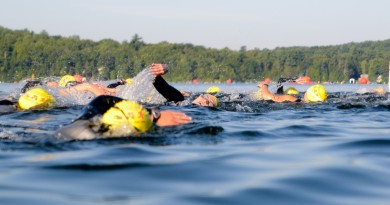Don’t Let Swimming Keep You From Triathlons | Techniques to Conquer the Intimidating First Leg
When my husband, Alex Gratton, started to learn how to swim—actually swim, not just jump in the water and dog paddle around—he started to get very frustrated with his slow progress, and that he couldn’t keep up with me.
Alex is a very fit athlete, but in the water it didn’t matter how much effort he put in. (In his last triathlon, he got out of the water and onto his bike and was passing 10-year-olds on mountain bikes, who had passed him in the water).
For many triathletes, seasoned and just beginning, swimming is the most challenging leg and often the weakest of the three disciplines. Many athletes are left disheartened when their long swims are not paying off in increased speed.
Training for the swim leg is different from training for running and biking. Unlike cycling and running, which are improved through time and strength training, swimming is all about technique and form. To improve your swimming, spend some time focusing on basic body mechanics. Here are three concepts and drills to incorporate in your next pool or open-water swim that will re-teach your body how to move in the water for increased fluidity and speed.
1. Swim horizontally: Get your hips up! Your body should be parallel to the surface of the water. Some people describe it as swimming through a tube: wherever your head and shoulders go your hips and legs follow. Having your hips sink and legs drop creates resistance and makes it harder to swim. Your kick should extend from your hips, not your knees. As you swim, use a flutter kick without making huge splashes.
Kick-only drill: Put your hands out in front of you in a glide position, Get your legs straight out behind you and start your kick at your hips. Think hips up!
2. Rotate from side to side. Each stroke you take rolls your body slightly to one side so you are basically swimming on one shoulder and then the next. It is easier to pull your shoulder through the water than it is to pull your whole chest (less resistance). Also, this side-swimming engages your back muscles to pull instead of just using your arm muscles.
Side-swimming drill: Flutter kick as you swim on one side, right arm extended out, then rotate to the other side, left arm extended out. Take several seconds kicking and holding on each side before you rotate. Turn your head up when you need to breathe.
3. Pull your body through the water instead of moving water past you. With each stroke, think about “taking a hold” of the water in front of you as you pull your body to that next spot in the water. Get more bang for your pull by using your forearm too. Keep your arm under your body as you pull.
Closed-fist drill, or 5-4-3-2-1-finger drill: Swim normally, but close your fist or gradually decrease the number of fingers helping you pull. Your arm reaches out in front of your body, and as it comes toward you, have your arms pass right under your belly and exit the water by your hips. With less of your hand to scoop, you will engage your forearm to pull.
When swim training for a triathlon, also spend some time practicing in open water, coordinating your breathing with your movements—it’s a whole different swimming experience. I could write a whole article just on breathing, but find something that is comfortable and try to breath bi-laterally (both sides).
Focusing more on how the body moves in the water provides greater gains in speed than swimming thousands of meters. With work on basic body mechanics in the water, my husband is getting faster and feeling more confident. That’s great for him, but if I still want to be able to beat him at something, maybe I shouldn’t let him read this article.
Here are some great triathlon and swim-training opportunities. Enjoy the water!
- June 21–24 Troy Jacobson Triathlon Camp, Lake Placid, New York.
- August 23–26, QT2 Vermont Training Camp, Ludlow. Ironman and 70.3 focus.
- Race Vermont’s Swim Training for Triathlon, Friday mornings at 5:45 a.m., starting June 15, Shelburne.
- Elmore Practice Triathlons, Elmore. Thursday, June 12 and 26; July 10 and 24, 6:30 p.m.


